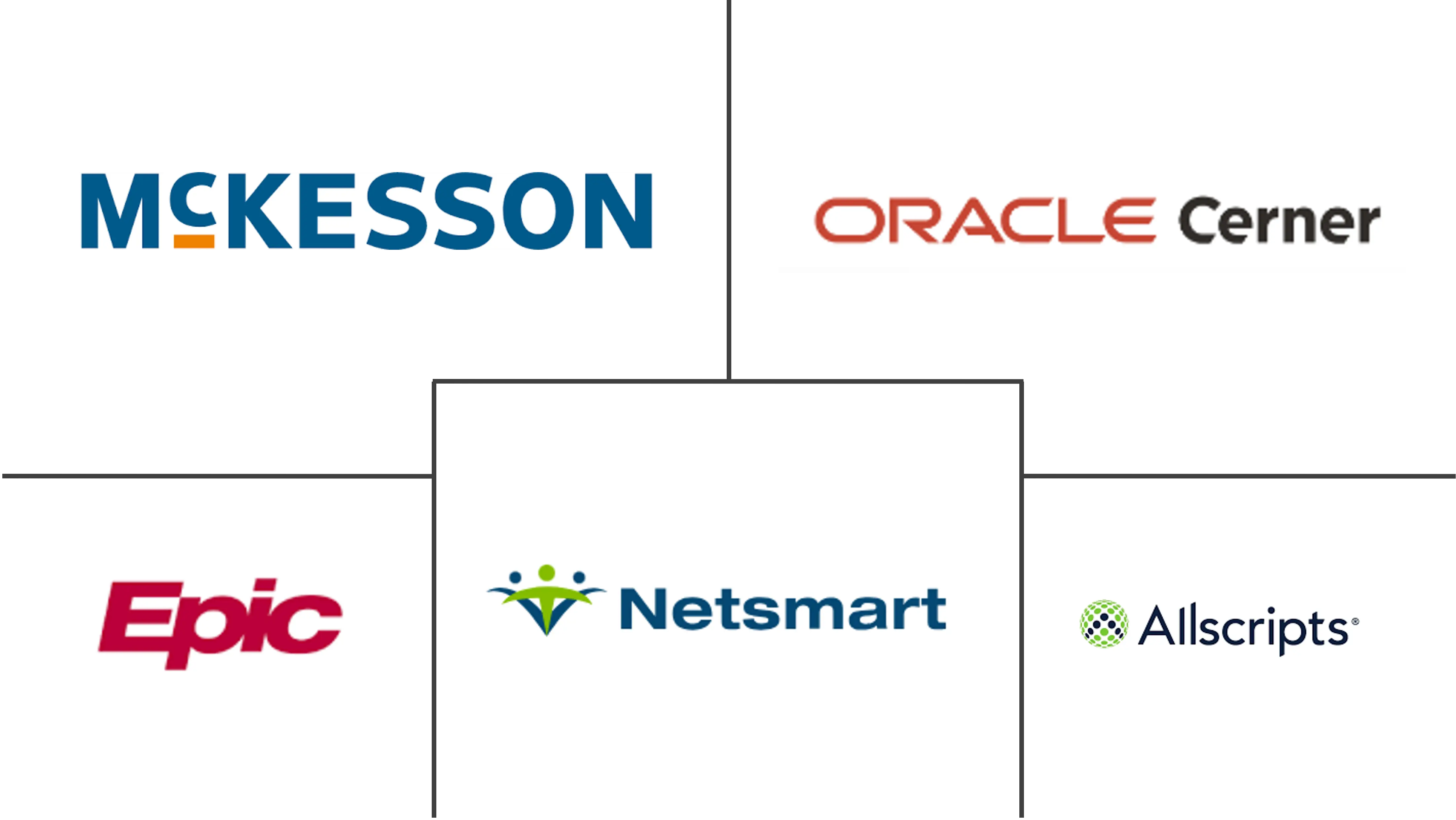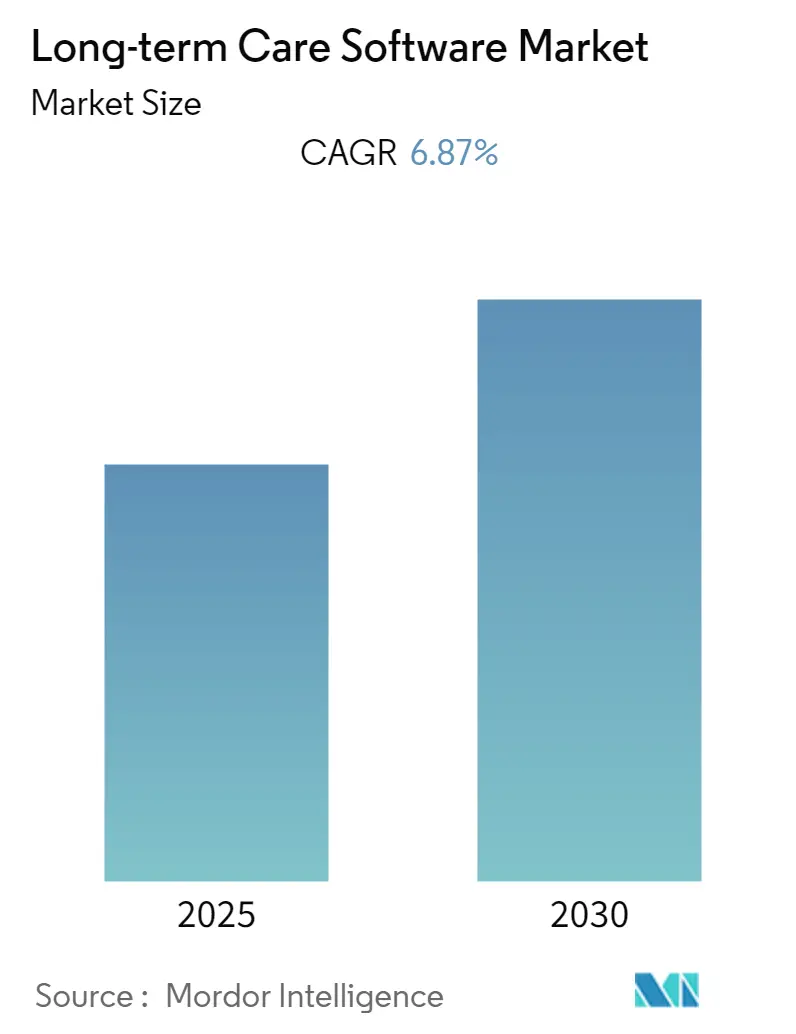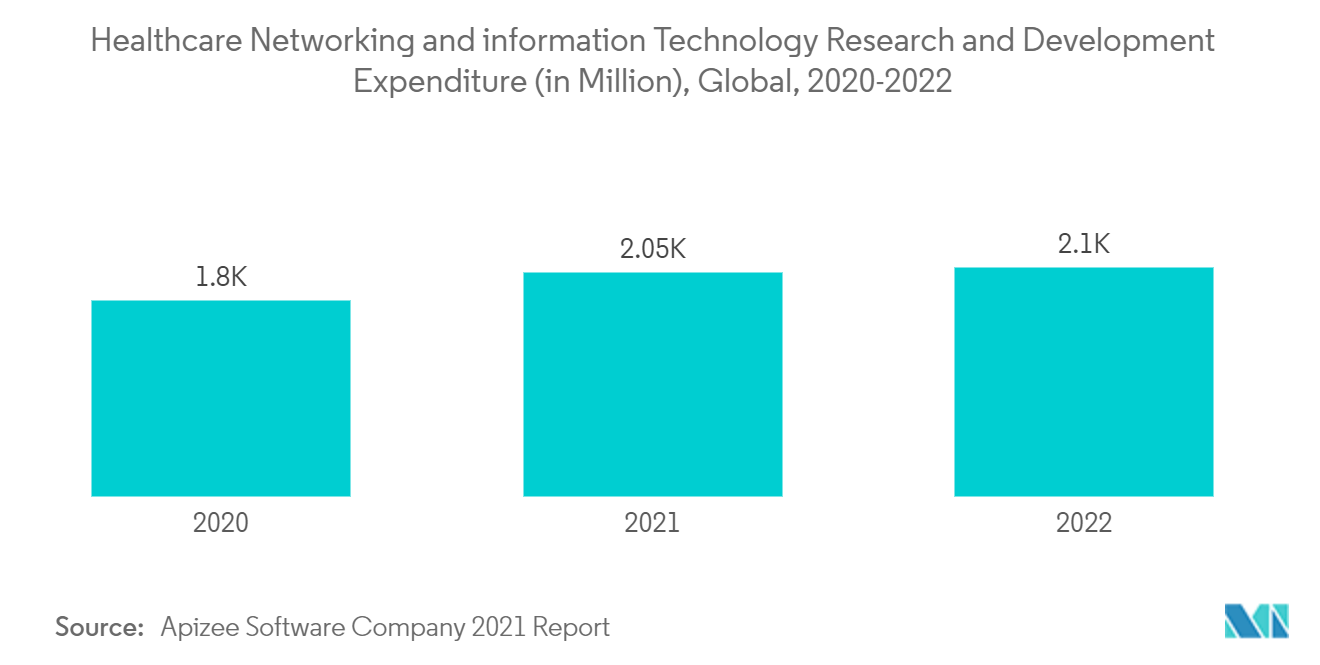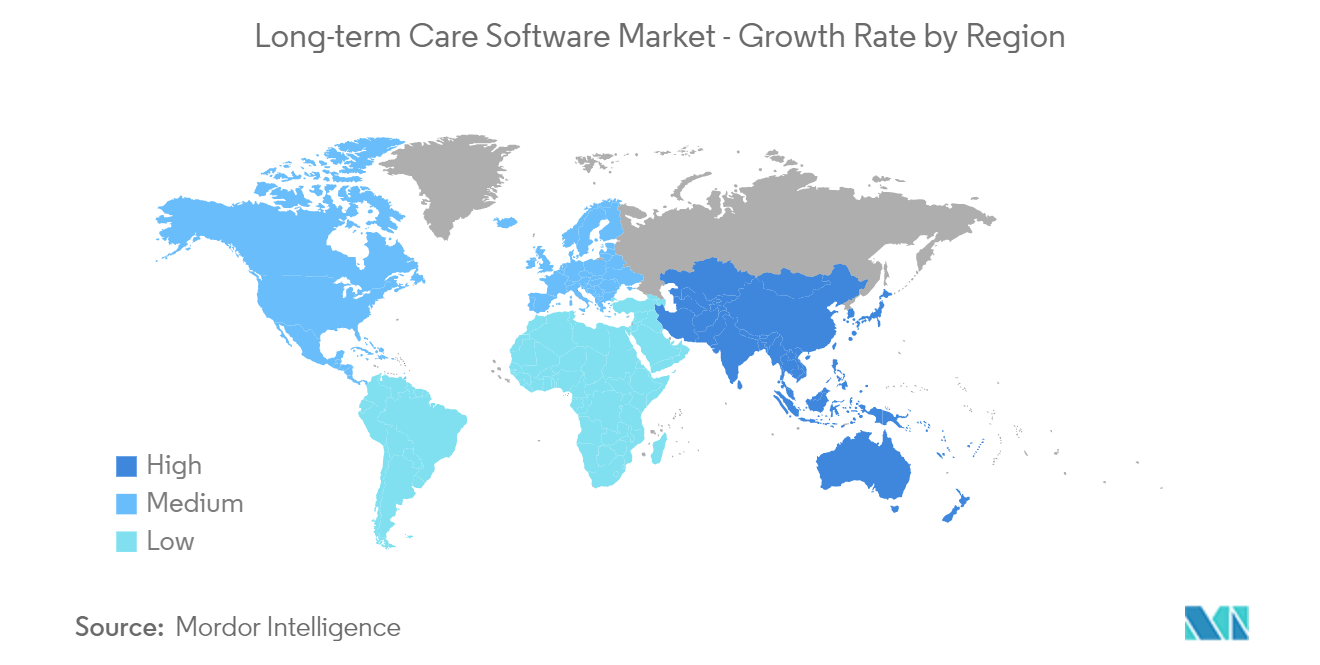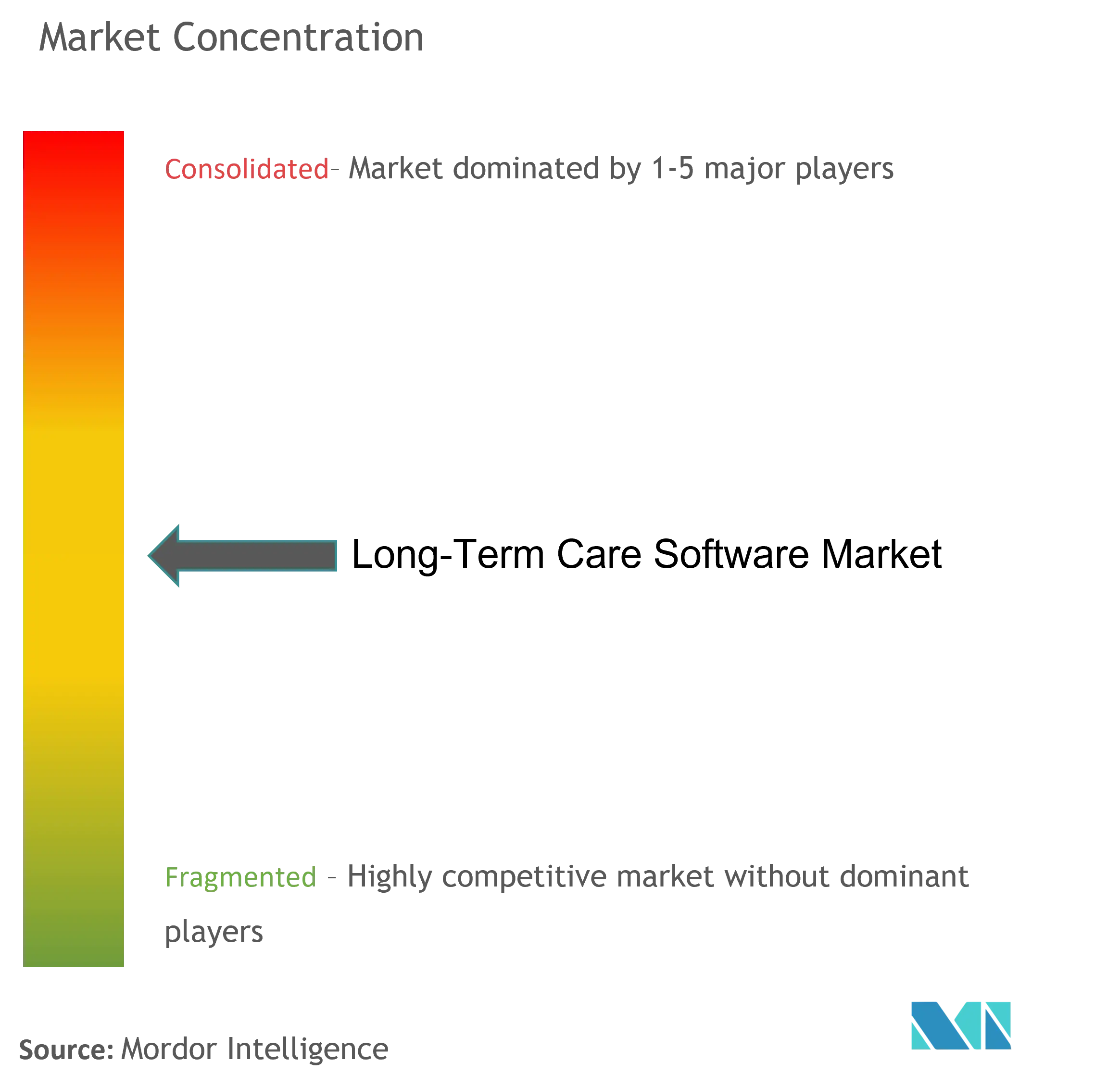Long Term Care Software Market Analysis
The Long-term Care Software Market is expected to register a CAGR of 6.87% during the forecast period.
The COVID-19 pandemic affected the elderly population excessively, particularly those who were living at long-term care facilities (LTCF), with a significant impact on mortality and morbidity. As per the study article published in PLUS One in January 2022, the mortality rate among long-term care residents was higher. Thus, strenuous action is required to alleviate the impact of COVID-19 by enhancing infection prevention and control (IPC) measures within LTCF with novel and advanced LTC software and solutions to track and manage the patients at LTCF affected with COVID-19. In addition, during the later phases of the pandemic, GHD Group Pty Ltd revealed four new advanced solutions, namely, SimpleTrack, Contact Connect Wearables, Appointed, and Wastewater testing service, intended to increase the safety of residents in long-term care facilities through contact tracing, appointment bookings, and early notification of COVID-19 trends. Thus, as per the analysis, COVID-19 significantly impacted the growth of the studied market throughout the pandemic phase and is expected to continue its trend over the post-pandemic era.
The major factors attributing to the growth of the long-term care software market are healthcare reforms and government initiatives, the rise in the aging population, and the growing burden of chronic diseases. As per the WHO data updated in October 2022, the number of people over 60 years and above is expected to reach 1.4 billion by the year 2030 and is projected to reach 2.1 billion by the year 2050. As old people require long-term care, the demand for long-term care software is anticipated to grow and contribute to the market's growth during the forecast period.
Additionally, among the patients requiring long-term care, some of the most frequent chronic medical conditions include hypertension, gastroesophageal reflux disease, diabetes, atrial fibrillation, anemia, arthritis, congestive heart failure, constipation, chronic obstructive pulmonary disease, cerebrovascular disease, dementia, osteoporosis, Parkinson's disease, peripheral vascular disease, renal failure, and thyroid disorders, amongst others. According to Alzheimer's Disease International, someone develops dementia every 3 seconds. As per the above source, the number of people with dementia is expected to double every 20 years; by 2030, it is anticipated to reach 78 million, and by 2050, nearly 139 million. Therefore, to control and monitor such a large section of the old age population prone to any chronic disease at any point in time, even if the disease occurred once, it is important to get them monitored at home care, nursing facility, or community centers, as well as assisted living centers. The importance of software and devices to connect to these centers and patients becomes necessary, and thus, acts as one of the major drivers for the market studied.
Moreover, government policies and acts, such as the Health Information Technology for Economic and Clinical Health Act (HITECH), improve healthcare quality, safety, management, and efficiency, including electronic health records (EHRs) and private and secure electronic health information exchange are vital in proper disease management to alert clinicians promptly. Hence, the demand for long-term care software is increasing. This is further anticipated to fuel the market growth.
Long Term Care Software Market Trends
Electronic Health Records Projected to Have Notable Growth Rate Over the Forecast Period
Electronic Health Records (EHRs) are highly useful in managing documentation, quality outcomes, and health outcomes. The boost in productivity in healthcare facilities was observed over two years. Increasing public and private financial incentives for EHR adoption is driving the growth of the overall segment. The EHR can improve the quality of care in Long-term Care facilities by reducing medication-related errors, improving clinical documentation and decision-making, and through the Health Information Exchange.
The increasing financial support governments provide through public budgets worldwide is leading to the development healthcare systems and contributing to the growth of the studied market. For instance, in April 2021, Seqster PDM Inc. invested USD 12 million, led by OmniHealth Holdings LLC and Takeda Digital Ventures, to drive Seqster's capabilities to develop and enhance its technology and boost the adoption of its healthcare data interoperability technology in healthcare. Such investments are anticipated to positively impact the segment's growth during the forecast period.
Due to the COVID-19 pandemic, patients' reliance on online sources increased, making it compulsory for healthcare providers to develop easy-to-access health record platforms. For instance, in January 2021, MEDITECH launched its COVID-19 Vaccination EHR solution, intending to streamline COVID-19 vaccine administration across health systems. These EHR registries can identify eligible patients for the vaccine and show which long-term facility residents have pre-existing conditions. Hence, these developments during the pandemic fueled the segment's growth.
Moreover, product launches are anticipated to contribute to the segment's growth. For instance, in February 2021, Capital Health launched a new EHR system across its two hospitals' acute care areas to better serve the community and its patients. In addition, in November 2022, Medidata planned to launch Rave Companion, an innovative, scalable technology helping clinical trial sites save time and reduce errors in transferring EHR data to the Rave electronic data capture (EDC) system. Rave Companion addresses the long-standing industry challenge of duplicate data entry by enabling structured and unstructured data from any electronic health record directly utilized by Rave EDC within a few clicks. These developments are further anticipated to fuel the segment's growth over the forecast period.
North America is Expected to Hold a Significant Share of the Market Over the Forecast Period
North America is expected to hold a significant market share of the overall market studied throughout the forecast period. This is due to the increasing geriatric population, favorable government policies, and widespread insurance coverage.
In North America, the high adoption rate of new technology software services nationwide is expected to further contribute to the market growth. For instance, the Drug Enforcement Administration (DEA) allowed practitioners to write prescriptions for controlled substances electronically. This allows for a reduction in prescription errors caused by illegible handwritten prescriptions. Similarly, at the national level, the National Institute on Aging (NIA) helps conduct and support research on aging and the health and well-being of older people. At the state level, some of the programs include the National Association of States United for Aging and Disabilities (NASUAD), Minnesota's Long-Term Care Choices Navigator, Massachusetts Department of Elder Affairs, and the Georgia Department of Human Services (DHS) Division of Aging Services, among others. Therefore, due to the availability of such government organizations focusing on long-term care, the demand for long-term care software is increasing in the country and driving the studied market growth.
Furthermore, the engagement of market players and government organizations is expected to contribute to the market's growth during the forecast period. For instance, in October 2021, the University of New Mexico Health System developed the MyHealthUNM patient portal and a new personal health record application called mCharts, which presents patient information in an interactive and easy-to-use format. This development is allowing patients in the University of New Mexico Health System to access their medical information online, and they are responding well to these tools.
In addition, in April 2022, Pixalere Healthcare reported the launch of its new clinically-focused EMR application, HERO (Homecare Electronic Record Outcomes). HERO is a robust digital reporting and digital forms solution allowing the full transition from paper to electronic charting, which was developed in collaboration with VHA Home Healthcare, a Toronto-based homecare provider. Also, Pixalere is planning to partner with homecare providers across Canada to introduce the benefits of HERO. Thus, such developments in the countries in North America are driving the growth of the studied market. Therefore, owing to the abovementioned factors, the market studied is expected to witness a significant share in North America.
Long Term Care Software Industry Overview
The long-term care software market is moderately competitive and has several major players. In terms of shares, a few of the major players currently dominate the market. With the rising patient awareness levels and increasing geriatric population, a few other smaller players are expected to enter the market in the coming years. Some major players in the market include Allscripts Healthcare Solutions, Cerner Corporation (Oracle), McKesson Corporation, Epic Systems Corporation, and Netsmart Technologies Inc.
Long Term Care Software Market Leaders
-
McKesson Corporation
-
Allscripts Healthcare Solutions
-
Netsmart Technologies Inc.
-
Cerner Corporation (Oracle)
-
Epic Systems Corporation
- *Disclaimer: Major Players sorted in no particular order
Long Term Care Software Market News
- March 2023: Sapiens International Corporation launched its state-of-the-art Customer Acquisition solution in collaboration with EquiTrust, a leading North American life and health insurance company. It empowers EquiTrust's marketing partners to illustrate, sell and complete digital application entries for a newly available Annuity/Long Term Care hybrid insurance product, Bridge, leveraging Sapiens' award-winning IllustrationPro and ApplicationPro to provide a next-generation digital experience.
- February 2022: Creative Solutions in Healthcare (CSNHC) launched a new software platform, Connected Care Center, to increase transparency in its 92 skilled nursing facilities.
Long Term Care Software Industry Segmentation
As per the report's scope, long-term care software refers to software services that include electronic medical records, e-prescribing, medication management, patient monitoring, remote training, etc., which enhance the business operation's needs, patient experience, and outcomes. The Long-term Care Software Market is Segmented by Product (Electronic Health Records, E-prescribing, Clinical Decision Support Systems, Remote Patient Monitoring Systems, Real-time Location Systems, Billing, Invoicing, and Scheduling Software, and Other Products), Deployment (Cloud Bases and On-premise), End User (Home Healthcare Agencies, Hospice Care Facilities, and Nursing Homes and Assisted Living Facilities), and Geography (North America, Europe, Asia-Pacific, Middle-East and Africa, and South America). The report also covers the estimated market sizes and trends for 17 countries across major regions globally. The report offers the value (in USD) for the above segments.
| By Product | Electronic Health Records | ||
| E-prescribing | |||
| Clinical Decision Support Systems | |||
| Remote Patient Monitoring Systems | |||
| Real-Time Location Systems | |||
| Billing, Invoicing, and Scheduling Software | |||
| Other Products | |||
| By Deployment | Cloud-based | ||
| On-premise Based | |||
| By End-User | Home Healthcare Agencies | ||
| Hospice Care Facilities | |||
| Nursing Homes and Assisted Living Facilities | |||
| Geography | North America | United States | |
| Canada | |||
| Mexico | |||
| Europe | Germany | ||
| United Kingdom | |||
| France | |||
| Italy | |||
| Spain | |||
| Rest of Europe | |||
| Asia-Pacific | China | ||
| Japan | |||
| India | |||
| Australia | |||
| South Korea | |||
| Rest of Asia-Pacific | |||
| Middle East and Africa | GCC | ||
| South Africa | |||
| Rest of Middle East and Africa | |||
| South America | Brazil | ||
| Argentina | |||
| Rest of South America | |||
Long Term Care Software Market Research FAQs
What is the current Global Long-term Care Software Market size?
The Global Long-term Care Software Market is projected to register a CAGR of 6.87% during the forecast period (2025-2030)
Who are the key players in Global Long-term Care Software Market?
McKesson Corporation, Allscripts Healthcare Solutions, Netsmart Technologies Inc., Cerner Corporation (Oracle) and Epic Systems Corporation are the major companies operating in the Global Long-term Care Software Market.
Which is the fastest growing region in Global Long-term Care Software Market?
Asia Pacific is estimated to grow at the highest CAGR over the forecast period (2025-2030).
Which region has the biggest share in Global Long-term Care Software Market?
In 2025, the North America accounts for the largest market share in Global Long-term Care Software Market.
What years does this Global Long-term Care Software Market cover?
The report covers the Global Long-term Care Software Market historical market size for years: 2019, 2020, 2021, 2022, 2023 and 2024. The report also forecasts the Global Long-term Care Software Market size for years: 2025, 2026, 2027, 2028, 2029 and 2030.
Our Best Selling Reports
Long Term Care Software Industry Report
Statistics for the 2025 Long-term Care Software market share, size and revenue growth rate, created by Mordor Intelligence™ Industry Reports. Long-term Care Software analysis includes a market forecast outlook for 2025 to 2030 and historical overview. Get a sample of this industry analysis as a free report PDF download.

